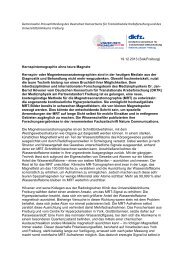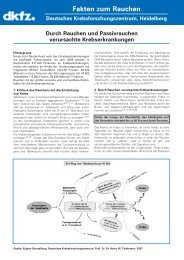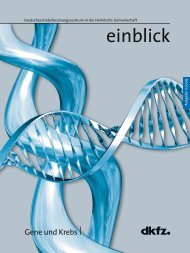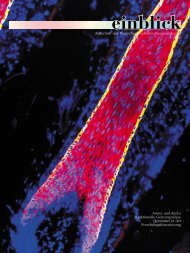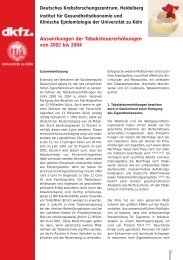MDCK-MRP2 - Dkfz
MDCK-MRP2 - Dkfz
MDCK-MRP2 - Dkfz
Erfolgreiche ePaper selbst erstellen
Machen Sie aus Ihren PDF Publikationen ein blätterbares Flipbook mit unserer einzigartigen Google optimierten e-Paper Software.
Forschungsschwerpunkt A<br />
Zell- und Tumorbiologie<br />
Diese Ergebnisse legen eine wichtige Funktion des Glukokortikoidrezeptors<br />
in der Regulation des Größenwachstums<br />
nahe. Interessanterweise erfolgt die Hemmung des Wachstums<br />
nicht in der dimerisierungsdefekten Glukokortikoidrezeptor-Mutante.<br />
Detaillierte Analyse der Rolle des Rezeptors<br />
in der Wachstumsregulation zeigt, daß der Rezeptor<br />
als Co-Aktivator für Stat5 wirkt, ohne DNA binden zu müssen.<br />
Weiter führt Verlust des Glukokortikoidrezeptors in<br />
der Leber zur schweren Hypoglykämie in experimentell gesetztem<br />
Diabetes. Diese Beobachtungen weisen auf einen<br />
wichtigen Beitrag der Glukokortikoid-abhängigen Genexpression<br />
in der Entwicklung der diabetischen Stoffwechsellage<br />
hin [28]. In Zusammenarbeit mit der Gruppe von<br />
U. Schibler, Universität Genf, konnten wir zeigen, daß Glukokortikoide<br />
und der Rezeptor an der Regulation der<br />
circadianen Uhr [29] sowie bei der Regulation der Brustdrüse<br />
(T. W intermantel, eingereicht) beteiligt sind.<br />
Um zellspezifische Inaktivierung des Östradiolrezeptors zu<br />
erreichen, wurde Exon 3 durch Insertion von loxP-Sequenzen<br />
markiert [30]. Mit Hilfe dieser Mutante haben wir das<br />
Gen für den Rezeptor in der Brustdrüse und im zentralen<br />
Nervensystem inaktiviert (T. Wintermantel, unveröffentlicht).<br />
Verlust des Östradiolrezeptors in epithelialen Zellen<br />
der Brustdrüse führt zu einer verzögerten Brustdrüsenentwicklung.<br />
Inaktivierung des Östradiolrezeptors im Gehirn<br />
wird uns wichtige Hinweise über die zentrale Steuerung<br />
der ovariellen Funktion geben.<br />
Um die Funktion des Mineralokortikoidrezeptors (MR) in vivo<br />
verstehen zu lernen, haben wir das Gen inaktiviert. MR<br />
Knockout-Mäuse sterben etwa 10 Tage nach der Geburt<br />
und zeigen verminderte Amilioride-sensitive Natrium-Rückresorption.<br />
Um die Funktion besser verstehen zu lernen,<br />
haben wir ein konditionales MR-Allel erzeugt (MRflox ). Durch<br />
Expression der Cre-Rekombinase wurde eine Mutation im<br />
Hippocampus entwickelt. Diese Tiere zeigen eine stark verminderte<br />
Gedächtnisleistung (S. Berger, unveröffentlicht).<br />
Mit diesen Mutanten konnte zum ersten Mal eine Funktion<br />
des Mineralokortikoidrezeptors im Hippocampus gezeigt<br />
werden. Wie der Mineralokortikoidrezeptor mit dem Glukokortikoidrezeptor<br />
im Hippocampus zusammenwirkt, wird<br />
eine wichtige Frage für zukünftige Arbeiten sein.<br />
Publikationen (* = externer Koautor)<br />
[1] Bleckmann, S., Blendy, J.A., Rudolph, D., Monaghan, A.P.,<br />
Schmid, W., and Schütz, G. (2002). ATF-1 and CREB are important<br />
for cell survival during early mouse development. Mol. Cell.<br />
Biol. 22, 1919-1925.<br />
[2] Casanova, E., Fehsenfeld, S., Mantamadiotis, T., Lemberger,<br />
T., Greiner, E., Stewart*, A.F., and Schütz, G. (2001). A<br />
CaMKIIalpha iCre BAC allows brain-specific gene inactivation.<br />
Genesis 31, 37-42.<br />
[3] Balschun*, D., Wolfer*, D.P., Gass, P., Mantamadiotis, T.,<br />
Welzl*, H., Schütz, G., Frey*, J.U., and Lipp*, H.-P. (2003). Does<br />
CREB have a pivotal role in hippocampal synaptic plasticity and<br />
hippocampus-dependent memory? J. Neurosci. 23, 6304-6314.<br />
[4] Mantamadiotis, T., Lemberger, T., Bleckmann, S., Kern, H.,<br />
Kretz, O., Villalba-Martin, A., Tronche, F., Kellendonk, C., Gau,<br />
D., Kapfhammer*, J., Otto, C., Schmid, W., and Schütz, G.<br />
(2002). Disruption of CREB function in brain leads to<br />
neurodegeneration. Nat. Genet. 31, 47 - 54.<br />
[5] Casanova, E., Lemberger, T., Fehsenfeld, S., Greiner, E., and<br />
Schütz, G. (2002). Rapid localisation of a gene within BACs and<br />
PACs. BioTechniques 32, 240-242.<br />
[6] Casanova, E., Fehsenfeld, S., Greiner, E., Stewart*, A.F.,<br />
and Schütz, G. (2002). Construction of a conditional allele of<br />
RSK-B/MSK2 in the mouse. Genesis 32, 158-160.<br />
Abteilung A020<br />
Molekularbiologie der Zelle I<br />
[7] Casanova, E., Fehsenfeld, S., Greiner, E., Stewart*, A.F.,<br />
and Schütz, G. (2002). Conditional mutagenesis of CamKIV. Genesis<br />
32, 161-164.<br />
[8] Shimshek*, D.R., Kim*, J.H., Hübner*, M.R., Spergel*, D.J.,<br />
Buchholz*, F., Casanova, E., Schütz, G., Stewart*, A.F.,<br />
Seeburg*, P.H., and Sprengel*, R. (2002). Codon-optimized Cre<br />
recombinase expression in the mouse. Genesis 32, 19-26.<br />
[9] Behrens*, A., Sibilia*, M., David*, J.-P., Schütz, G., and<br />
Wagner*, E.F. (2002). Impaired postnatal hepatocyte proliferation<br />
and liver regeneration in mice lacking c-jun in the liver. EMBO<br />
J. 21, 1782-1790.<br />
[10] Coffinier*, C., Gresh*, L., Fiette*, L., Tronche, F., Schütz,<br />
G., Babinet*, C., Pontoglio*, M., Yaniv*, M., and Barra*, J.<br />
(2002). Bile system morphogenesis defects and liver dysfunction<br />
upon targeted deletion of HNF1beta. Development 129, 1829-<br />
1838.<br />
[11] Beißbarth, T., Borisevich, I., Hörlein, A., Kenzelmann, M.,<br />
Hergenhahn, M., Klewe-Nebenius, A., Klären, R., Korn, B.,<br />
Schmid, W., Vingron, M., and Schütz, G. (2003). Analysis of<br />
CREM-dependent gene expression during mouse spermatogenesis.<br />
Mol. Cell. Endocrinol. 212, 29-39.<br />
[12] Gau, D., Lemberger, T., von Gall, C., Kretz, O., Le Minh*, N.,<br />
Gass, P., Schmid, W., Schibler*, U., Korf*, H.W., and Schütz, G.<br />
(2002). Phosphorylation of CREB Ser-142 regulates light-induced<br />
phase shifts of the circadian clock. Neuron 34, 245-253.<br />
[13] Otto, C., Kovalchuk*, Y., Wolfer*, D.P., Gass, P., Martin*,<br />
M., Zuschratter*, W., Gröne, H.-J., Kellendonk, C., Tronche, F.,<br />
Maldonado*, R., Lipp*, H.-P., Konnerth*, A., and Schütz, G.<br />
(2001). Impairment of mossy fiber long-term potentiation and<br />
associative learning in pituitary adenylate cyclase activating<br />
polypeptide type I receptor-deficient mice. J. Neurosci. 21,<br />
5520-5527.<br />
[14] Otto, C., Martin*, M., Wolfer*, D.P., Lipp*, H.-P.,<br />
Maldonado*, R., and Schütz, G. (2001). Altered emotional behavior<br />
in PACAP-type-I-receptor-deficient mice. Mol. Brain Res.<br />
92, 78-84.<br />
[15] Reichardt, H.M., Tronche, F., Berger, S., Kellendonk, C., and<br />
Schütz, G. (2000). New insights into glucocorticoid and mineralocorticoid<br />
signalling - lessons from gene targeting. In Hormones &<br />
Signalling, Advances in Pharmacology 47 (ed. B. O´Malley), Volume<br />
47, B. O´Malley, ed. (San Diego: Academic Press), pp. 1-21.<br />
[16] Schulz-Baldes*, A., Berger, S., Grahammer*, F., Warth*, R.,<br />
Goldschmidt*, I., Peters*, J., Schütz, G., Greger*, R., and<br />
Bleich*, M. (2001). Induction of the epithelial NA+ channel via<br />
glucocorticoids in mineralocorticoid receptor knockout mice.<br />
Pflüger´s Arch. Eur. J. Histol. 443, 297-305.<br />
[17] Reichardt, H.M., Kaestner, K.H., Wessely, O., Tuckermann,<br />
J., Angel, P., Kretz, O., Bock*, R., Schmid, W., Herrlich*, P., and<br />
Schütz, G. (1998). DNA binding of the glucocorticoid receptor is<br />
not essential for survival. Cell 93, 531-541.<br />
[18] Reichardt, H.M., Tuckermann, J.P., Göttlicher*, M., Vujic, M.,<br />
Weih*, F., Angel, P., Herrlich*, P., and Schütz, G. (2001). Repression<br />
of inflammatory responses in the absence of DNA-binding by<br />
the glucocorticoid receptor. EMBO J. 20, 7168-7173.<br />
[19] Reichardt, H.M., Umland, T., Bauer, A., Kretz, O., and<br />
Schütz, G. (2000). Mice with an increased glucocorticoid receptor<br />
gene dosage show enhanced resistance to stress and endotoxic<br />
shock. Mol. Cell. Biol. 20, 9009-9017.<br />
[20] Kenzelmann, M., Klären, R., Hergenhahn, M., Bonrouhi, M.,<br />
Gröne, H.-J., Schmid, W., and Schütz, G. (2003). High accuracy<br />
amplification of nanogram total RNA amounts for gene profiling.<br />
Genomics 83, 550-558.<br />
[21] Limbourg*, F.P., Huang*, Z., Plumier*, J.-C., Simoncini*, T.,<br />
Fujioka*, M., Tuckermann, J., Schütz, G., Moskowitz*, M.A., and<br />
Liao*, J.K. (2002). Enhancement of cerebral blood flow and<br />
stroke protection mediated by non-nuclear actions of the glucocorticoid<br />
receptor. J. Clin. Invest. 110, 1729-1738.<br />
[22] Tronche, F., Kellendonk, C., Reichardt, H.M., and Schütz, G.<br />
(1998). Genetic dissection of glucocorticoid receptor function in<br />
mice. Curr Opin Genet Dev 8, 532-538.<br />
DKFZ 2004: Wissenschaftlicher Ergebnisbericht 2002 - 2003<br />
27



